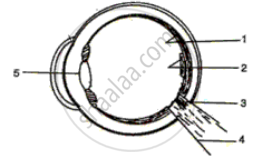Advertisements
Advertisements
प्रश्न
Complete the following sentence with appropriate word :
An inability to focus on nearby objects due to loss of elasticity of the lens with age is called Iris.
उत्तर
An inability to focus on nearby objects due to loss of elasticity of the lens with age is called Iris.
APPEARS IN
संबंधित प्रश्न
The kind of lens required to correct Myopia
Which defect of vision can be rectified:
by using a concave lens?
Name the body part with which the terms myopia and hypermetropia are connected.
Your friend can read a book perfectly well but cannot read the writing on blackboard unless she sits on the front row in class.
Is she short-sighted or long-sighted?
A person suffering from the eye-defect myopia (short-sightedness) can see clearly only up to a distance of 2 metres. What is the nature and power of lens required to rectify this defect?
The defect of vision which cannot be corrected by using spectacles is:
(a) myopia
(b) presbyopia
(c) cataract
(d) hypermetropia
Describe the mechanism of focusing the image of a distant object in your eye when you raise your head after reading a book.
State one role of ciliary muscles in the human eye.
State the main functions of the following:
Tears
Distinguish between the following pair of words:
Myopia and hypermetropia
The diagram alongside represents a section of a mammalian eye.
(i) Label the parts 1 to 5 of the diagram.
(ii) State the function of the parts labelled 4 and 5.
(iii) With the help of a diagram show the short sightedness.

Rewrite the following table so as to match second and third column with first column.
|
Column I
|
Column II
|
Column III
|
|
(i) Myopia
|
Old age problem
|
Bifocal lens
|
|
(ii) Presbyopia
|
Nearsightedness
|
Concave lens.
|
Explain the Term: Presbyopia
What type of lens is used to correct Hypermetropia?
The diagram given below represents the cross-section of the human eye:

(i) Name the parts labeled 1—12.
(ii) What is the function of the part marked ‘10’?
(iii) What would happen if part ‘5’ is damaged or cut?
Given below is a diagrammatic representation of a defect of the human eye:

(i) Identify the defect.
(ii) Mention two reasons for the above defect.
(iii) State how the defect can be rectified.
(iv) Name the part of the eye responsible for maintaining the shape of the eyeball.
Choose the Odd One Out:
Nearsightedness: elongated eyeball : : farsightedness: _______
Nearsightedness : concave lens : : farsightedness : _______
Match the following:
| Column - I | Column - II |
| 1. Retina | a. Path way of light |
| 2. Pupil | b. Far point comes closer |
| 3. Ciliary muscles | c. near point moves away |
| 4. Myopia | d. Screen of the eye |
| 5. Hypermetropia | e. Power of accommodation |
